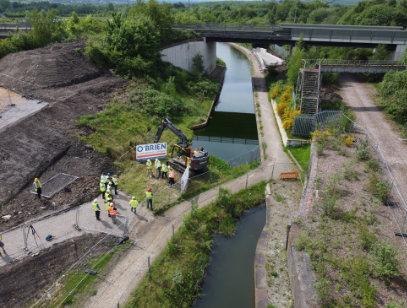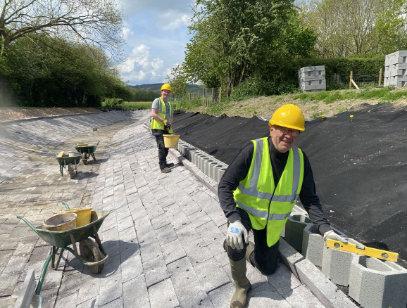










Regional mobile group Kescrg spent a weekend at Weymoor Bridge on the Cotswold Canals, preparing for the summer Canal Camps which will be working on putting a stream culvert under the canal. See Kescrg feature, page 37


For latest news on our activities visit our website wrg.org.uk
See Facebook group: WRG
Chairman’sComment good news and bad 4-5
Camps latest changes to the programme 5
Training weekend Report 6-7
Camp report Montgomery Canal 8-11
Archive a look back 50 years to 1974, the glory year of canal reopenings 12-17
Open the Avon a report from somebody who was actually there in 1974 18-19
Diary Camps and working weekends 20-21
Progress around the system 22-33
Leadership Teams Day reporting a day preparing leaders and cooks for summer 34-36
Kescrg a year in the life of an independent mobile group 37-39
PLEASE NOTE: subscriptions renewal cheques should be made out to The Inland Waterways Association. Note new address (right)
Follow us on @wrg_navvies
Editor: Martin Ludgate, 35 Silvester Road, East Dulwich London SE22 9PB. 020-8693 3266 martin.ludgate@wrg.org.uk
Contributions are welcome, by email or post, to the address above. If sending a lot of large picture files, please contact the editor first. Pressdateforissue326:15July.
Subscriptions: Ayear'ssubscription(6issues) isaminimum of £5.00 (please add a donation if you can) to WRG, Unit 16B, First Floor, Chiltern Court, Asheridge Road, Chesham HP5 2PX. Cheques must be made out to The Inland Waterways Association (although the proceeds will be put to WRG / Navvies use).
Distribution: John Hawkins, 4 Links Way, Croxley Green WD3 3RQ 01923 448559 john.hawkins@wrg.org.uk
Navvies is published by Waterway Recovery Group and is available to all interested in promoting or supporting the restoration and conservation of inland waterways by voluntary effort in Great Britain. Articles may be reproduced in allied magazines provided that the source is acknowledged. WRG may not agree with opinions expressed in this magazine, but encourages publication as a matter of interest. Nothing printed may be construed as policy or an official announcement unless so stated - otherwise WRG and IWA accept no liability for any matter in this magazine.
Waterway Recovery Group is part of The Inland Waterways Association, (registered office: Unit 16B, First Floor, Chiltern Court, Asheridge Road, Chesham HP5 2PX), a nonprofit distributing company limited by guarantee, registered in England no 612245, and registered as a charity no 212342. VAT registration no 342 0715 89. Directors of WRG: Rick Barnes, George Eycott, Helen Gardner, John Hawkins, Dave Hearnden, Nigel Lee, Mike Palmer, George Rogers, Jonathan Smith, Harry Watts.
ISSN: 0953-6655 © 2024 WRG
Cover picture: The liftbridge installed many years ago at the Lichfield Canal’s Darnford Lane site has finally got water and boats (albeit small ones so far) under it. Following the completion of the Lichfield & Hatherton Canals Restoration Trust ‘s Darnford Moors Ecology Park project supported by WRG Canal Camps labour and Biffa Awards funding, the length of canal was reopened at a celebration in April - see page 31. (picture by the editor) Back cover upper: Drone view of the ‘first sod’ ceremony launching work on the Chesterfield canal’s Staveley Town Deal project - see page 22. Back cover lower: Channel lining by Shropshire Union Canal Society volunteers on the Montgomery Canal’s Crickheath South project - see page 24
Such are the traditions of Waterway Recovery Group that I reckon a fair percentage of Navvies readers will be able to guess the main themes of this Chairman’s Comment…
“Ah, it’s that time of year – it will be mainly about how super things are looking for a great summer of Canal Camps”
“Ah, but don’t forget he will need to slide in how the Canal Camps schedule has changed a little since it was first published”.
Yep – you have got me bang to rights. As you will see from the box on the opposite page, we have been caught out by the issue of permissions on one of our sites and we have had to take some difficult decisions.
Given that one of the things that we are often complaining about is canal societies not getting permissions and planning in place early enough, isn’t it concerning / embarrassing that, this time, we appear to have failed ourselves? Well, yes, but it’s worth telling the whole story here…
First some background information - we have a general rule that all permissions (for example landowner consent, local authority planning permission, Environment Agency agreement) necessary for a Canal Camp have to be in place four weeks before the start of the Camp. This gives us enough time to take ‘executive action’ – it’s only fair to our volunteers, leaders and all the other people impacted by a significant change that they get enough warning to change holiday times, travel plans, train tickets, etc.
Regarding the Manchester, Bolton & Bury Canal site: only a fortnight ago it seemed that all permissions were in progress and would easily be in place ready for our ‘deadline’ (it was close, but all the stakeholders were working together). But then, at the last minute, an additional authority got involved and imposed some conditions that frankly could not be met within the deadline. Nobody had spotted that this authority could / should be involved, and it came as a surprise to everyone. Now, we could have joined together with the local society and spent the next few weeks arguing that the authority shouldn’t be imposing these conditions but (a) why would we upset a party that needs to come onboard? and (b) even if we were (eventually) successful it’s unlikely such resolution would be achieved in time for the Camps to start.
So what positives can we gain from this difficult decision? Hmmm – difficult, because this is a challenge WRG has always faced: treading the thin line between being optimistic / hopeful and being pessimistic / cynical. We have to be open to every opportunity, but have to be realistic and pragmatic about the likelihood these opportunities will come to pass. But that’s not really the issue here: yes it is about getting it right, but it’s also about spotting when it isn’t going right and dealing with it, both in terms of politics and practicalities and also making sure that you, the volunteer, don’t get messed about. Discussions at the Leadership Teams Day (of which more further down) concluded that one of the worst scenarios in terms of volunteer morale and motivation was not enough work or the wrong work. The WRG Board do understand this and I can assure you that this is at the top of our minds when we consider these difficult decisions.
So on to other issues around the restoration sector. Or perhaps I should say losses around the restoration sector.
Firstly, you may well have heard that one of our key staff in Head Office Jenny Hodson has been made redundant by WRG’s parent body the Inland Waterways Association. The WRG Board would like to make it clear that the first we knew of this was when Jenny told us that it had happened. We would also like to pass on our thanks for all the work Jenny put in over the time she was with us, as well as all the work she put in for the IWA branches and restoration societies.
Secondly, one of the ways the IWA sought to champion restoration was to appoint one
Manchester Bolton & Bury Canal Camps: Unfortunately as a result of unforeseen issues with obtaining the necessary permissions for the work, both of the week-long Canal Camps on this site (CC2024-04 on 7-14 July and CC2024-06 on 14-20 July) have had to be cancelled. All volunteers who had booked are due to have been contacted. As we go to press we are hoping to reschedule the work for later in the season but cannot confirm this. See wrg.org.uk or contact 01494-783453 / enquiries@wrg.org.uk
of its Trustees to be the ‘Restoration Trustee’. Their job was two-fold (bi-directional?): to ensure that the restoration sector was represented at IWA Trustee meetings; and to ensure that the restoration sector received any communication Trustees wished to send. This Trustee was Nick Dybeck and, to be frank, it was a pleasure working with him. However, for perfectly valid personal reasons, Nick has just resigned as Trustee (and hence as the Restoration Trustee).
Now these losses might be considered to be quite concerning. However I can relay a comment from IWA national Chairman Mike Wills at the last Trustees meeting: “I believe it is still essential for IWA to support WRG and the Restoration Hub”. What that support looks like in the face of these losses is still uncertain, but we shall keep you informed.
As you can tell from all of the above we do live in ‘interesting times’; however, as seasoned readers of this magazine will be able to reflect, this has pretty much always been the case.
But, as well as all this distraction, I’m pleased to say that pretty much all of the “normal stuff” has been going on:
� IWA Restoration Conference – a chance for us to both give and take messages to / from the whole Restoration sector. This was very enjoyable and showed that, despite all the rumours, most societies were not only in good health but also getting good results.
� WRG Training Weekend – another expertly organised session at Lichfield run by the wonderful Ali ‘Womble’ Bottomley: All sorts of volunteers (WRG leaders, WRG volunteers, local societies) receiving training in all sorts of disciplines (bricklaying, excavators, rollers, site tools, etc) with the goal of both improving the skillset in the sector and also making it more consistent.
� Leadership Teams Day – Dave ‘Evvo’ Evans led a wonderful, thought provoking event that achieve its main purpose – communication in both directions between the WRG Board and the Camp Leaders (and indeed a few local society Leaders who came along to see how WRG does it).
� Logistics Container Day – the usual crew met up to ensure each van and Canal Camps kit trailer was packed with “The Right Tool for the Right Job”.
To all this collaborative stuff we can add all the individual actions – like all the work George ‘Bungle’ Eycott has been doing to tweak the Driver Authorisation scheme to make it (a) accurate, (b) appropriate, (c) useful and (d) effective. And all the work that I know this year’s Canal Camp leaders are putting in to ensure that their camps will be (a) safe, (b) effective, and (c) fun.
I could go on, but you get the picture. Now it’s true that I took 800 words to give all the negative news at the start of this comment and I’ve only used 200 words for the second more positive half. But I can assure you that that is only really because its important that we don’t ignore or attempt to sweep under the carpet the trials and tribulations of the restoration sector. That the excuse for the 800 words.
As for the excuse for just using the 200 words for the second half well it’s pretty simple – you don’t need me to tell you about the background stuff. You are used to it, either because you are involved in it, or because every time you enjoy one of our events you know you are benefiting from it. My thanks to all those involved in the background. So that’s the end of this Comment, and even though it took some time to get there, I think it has concluded with how super things are looking for a great summer of Camps. Things may be rocky out there but WRG is feeling pretty strong right now.
See you on site somewhere this summer?
Mike Palmer
Every spring or early summer WRG runs a weekend of building up skills for summer Canal Camps and other work. Leader Ali reports…
Training Weekend Report: Lichfield Canal, May 18th/19th
It’s one of my favourite weekends of the year. There is nothing better than watching our amazing volunteer instructors imparting a wealth of knowledge to others, ensuring that the skill base across the network continues to grow, and that our sites remain safe and productive places to be. I love it, and it seems those who came to learn or refresh their skill set did too. It has been fantastic to receive such positive feedback about this team, without whom the training weekend would not happen. Many praised their dedication and hard work, and one took the time to say how impressed he was by the friendly yet thorough nature of his tutors. I think this sums them up well.
This year, we saw faces old and new attend, with lots of trainees from local society groups too. Sessions included halfday bricklaying courses, site tools, ride-on rollers, dumpers, excavators (of varying sizes) and vehicle and trailer training. On Saturday night, we spent several hours poring over a complete set of Navvies magazine, 1966 to now, which generated some rather deep discussions and a whole lot of laughter, even tears; it was a wonderful trip down memory lane.
I don’t know how she does it, but Jude managed to produce an extraordinary menu to keep us all very well fed and thoroughly spoilt all weekend – absolutely scrumptious, thank you!
I would like to pass on my sincere thanks to everyone who made the weekend: to the very best team of instructors, for their patience, incredible teaching skills and for being so generous with their time; to Lichfield &
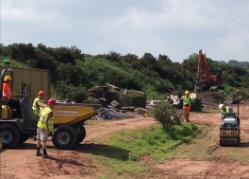

Hatherton Canals Restoration Trust for hosting us again, and particularly to Adrian for giving up his Friday and Monday to ensure that the materials and plant were delivered and removed without a hitch; to Jenny and Verena for their continued support at HQ; to Bungle for his invaluable phoneline support; to our first class chef, Jude Palmer, and to Mr P for doing what he does best; to everyone who helped with logistics and collecting vans; and finally to the trainees who were just lovely, and made everything worthwhile. THANK YOU! Let’s do it all again next year.
Ali ‘Womble’ Bottomley



Harri reports from a ‘mini-camp’ over the long Easter Weekend carrying out finishing works at the recently built Schoolhouse Bridge
Montgomery Canal Easter Camp Schoolhouse Bridge
At the March WRG Meeting, editor Martin agreed that if we got the camp report to him on the last day of the camp - Easter Tuesday - it could go in the next Navvies, traditionally one of the emptier issues due to less work happening over the winter. That meant however, that we needed to write the report
on the camp. Due to only having to cook for 11 (a third less time peeling veg) and ‘make your own lunch’ arrangements, plus the supermarket being only 10 minutes away and absolutely no phone signal at the accommodation limiting other distractions, this task got delegated to the cook. The following is therefore based on notes mostly made in the pub and may not be entirely accurate when it comes to on site details.
Length: 35 miles Locks: originally 26, 1 added during restoration, 3 at Newtown end not planned for restoration Date closed: breach shut canal 1936, officially abandoned 1944
The Canal Camp project: Finishing-off works at the recently built Schoolhouse Bridge
Why? With the reopening last year of the length of canal from near Maesbury to a new terminus at Crickheath, the section from there onwards is next for restoration. Shropshire Union Canal Society volunteers are already working on channel restoration, so reinstating the missing road bridge (replacing a low level crossing that blocked the canal) is a big step towards further reopenings.
The wider picture: Reopening the bridge removes the final major obstruction on the English length of canal. Together with the channel work it clears the way for linking up with restored length spanning the border at Llanymynech. Beyond there on the Welsh section, work is already funded to build two of the four new road bridges needed to get to Arddleen. That would link up with the start of a 12 mile restored length which reaches all the way through Welshpool and on to Refail. South of Refail, three locks have already been restored on the final section from there towards Newtown. If the remaining road blockages on this length can be dealt with, that might just provide the impetus to build the necessary diversion to bypass the lost final length and bring boats to a new terminus in Newtown.
Reopened in stages from Frankton to Crickheath1995-2023
Llangollen Canal Frankton To Hurleston Former Weston Arm To Llangollen
Maesbury
Crickheath
Refail
Garthmyl
Arddleen
Canal Camp site: Schoolhouse Bridge
Short restored length with tripboat at Llanymynech
Reopened in stages from Arddleen to Refail 1970s-2000
Three locks restored south of Refail but road blockages remain. Final length into Newtown blocked by sewer, terminus built on. Not planned for restoration but possible diversion to new terminus
The weather on our arrival day, Maundy Thursday, set the tone for the camp - wet. The volunteers came from multiple directions - Bristol, Warwickshire, Leicester, Essex, Southampton, London - and just about everyone complained about the dreadful driving conditions on the way. On site, in the rain, Adrian discovered one of the hired-in dumpers wouldn’t start, and Mike ‘MKP’ Palmer realised that we needed some way of transporting diesel to keep the plant running all weekend. At our accommodation, Porthywaen Silver Band Hall, the catering kit was unloaded and the WRG cooker installed (having received dire warnings in the introductory email from the hall booking secretary about the dangerous state of the cooker in situ), and lasagne, garlic bread and chocolate trifle were made and eaten. Most of the camp decamped across the road to the Lime Kilns pub, roughly tripling the number of punters.

Leader and assistant MKP and Rick Barnes needed to get down on site promptly on Friday morning, so they left the cook in charge of getting everyone else sorted to go to site, including taking out the tools needed from the trailer and packing them into a van, with help from Mike’s annotated kit list. I think only two people said “it would be easier to just take the trailer…” (we couldn’t because of limited space for turning on site).
The work for the camp was finishing-off the site around the new Schoolhouse Bridge, which has recently been rebuilt by contractors to provide sufficient clearance for the canal underneath. The bridge is about
half a mile from the current limit of navigation at Crickheath Wharf, with channel lining work already underway in between, so it felt like there was real purpose to the work with water likely to be flowing through in the foreseeable future. The work included removing the temporary road which had been the diversion while the bridge was being built, and using the stone to create a new compound area, with some other bits of landscaping and fence erecting.
Mostly this meant moving topsoil from one side of the bridge to the other and road stone in the opposite direction, while trying to keep the landowners of each of the four ‘sectors’ (both sides of the road, both sides of the canal) happy. To provide a safer route than using the road over the bridge as the dumper run, at the end of day 1 a small crew stayed on site a bit later to see if it was

Hopefully the dumper run will be looking more like a canal soon feasible to dig out enough of the channel under the bridge to be able to get the dumpers through. It turns out MKP plus a shovel at full stretch is about the height of a 3 tonne dumper with roll bar, fortunately.
After chicken and leek stew and hot cross bun bread and butter pudding for Good Friday, a smaller group of us went to pub, this time just doubling the clientele. We used the liquid inspiration to decide what needs to go in a briefing note on WRG and waterway restoration for people manning the stand for the Inland Waterways Association (WRG’s parent body) at waterway events.
By Saturday, the on-site toilet had been fixed, though this did involve input from about half the camp, and John’s ability to follow MKP’s excellent hand drawn map to find Screwfix in the new ‘Oswestry Gateway’ industrial estate (also featuring a Morrisons, drive through Costa and Premier Inn - quite a shock to someone who was last in Oswestry about 20 years ago). Lots of dumper and excavator work on site meant plenty of opportunities for training, including for our excellent DofE volunteer, Keira (who decided dumpers were the most fun).
Saturday night, after shepherds pie and cheesecake, we were the only people in the pub, though the landlady was remarkably cheerful given she’d been there since 11 that morning, so we must have been drinking enough!
Easter Sunday, after the clocks changed (cue minor moment of panic when the cook wasn’t completely sure her phone with no signal had actually adjusted the time of the alarm), dawned sunny and dry. So we started the day with an outing to ‘here’s one we made earlier’ at Aston Locks and nature reserve, including the obligatory explanation of how locks work (next time, we’ll remember to take a windlass too). Despite Oswestry now having about half a dozen builders’ merchants as well as the old faithful TGs (Tudor Griffiths), none of them are open on Easter Sunday when you need a large square fence post.
Nevertheless, good enough progress was made on the great topsoil/roadstone exchange that everyone was able to come back to the hall a bit early to tackle the weekend’s other task, the deconstruction and reconstruction of the IWA / WRG
Practical Restoration Handbook Volume 1. Who said canal camps don’t offer a variety of work? This involved adding the correct Guidance Note number to each booklet (neatly), removing the ring binder staples, restapling with normal staples and collating into sets. 80 times over for each of the 26 Guidance Notes. But by the end of the weekend, with a break for roast pork and apple crumble, all staples had been removed, everything had been numbered and progress had been made on restapling, though only having one long armed stapler did prove to be the pinch point of the process.
On Monday, half the camp went off to site to move more topsoil, while the other half did some more stapling, which given it was raining again, was a more attractive prospect than it sounded. The hoped-for early finish and visit to the restored lime kilns at Llanymynech was rather stymied by the late arrival of the landowner of the fourth ‘sector’, who seemed to think he’d agreed to something different from what was actually recorded in the paperwork. And of course, the heavens opened again just as it was time to empty the vans and pack the trailer. Several volunteers headed home after chicken and vegetable cheesy bake and chocolate brownies, but those of us left again stopped the pub landlord having an early night (“just shut the door when you go”).
All that was left to do on Tuesday morning was to pack up the catering kit, move the remaining Guidance Notes into John’s car, and clean the hall. In the end, as you’ll realise from the fact that you’re reading this two month later, I failed to make the Tuesday deadline for this report - I blame it on spending too much time during the camp updating cook’s guidance notes and not turning random notes into something readable, rather than on the tiredness that set in once home

from my first canal camp in over four years! But that might just mean by the time you read this the reseeded grass will have grown, the fence posts will have bedded in, and the channel under Schoolhouse Bridge will be looking more like a canal and less like a muddy hole.
Harri Barnes

“Here’s one we made earlier” - at Aston Locks
Part 2 of a look back half a century to 1974, a momentous year in the history of waterway restoration, as reported by Navvies magazine…
1974: a year to remember (if you can!) Part 2
As I explained in the introduction to the first part of this article in issue 324, a quick glane at the issues of Navvies published 50 years ago - or indeed at archive newspaper stories from that era - reveals some famliar stories: inflation hitting costs of canal restoration and everything else, deterioration of the navigable waterways network, and worries for its future given the impact of cost-cutting measures and loss of experienced staff.
But against this gloomy backdrop the waterway restoration movement celebrated a “year of reopenings” that put more navigable waterway back on the map than any other year until the Millennium Fund projects came to fruition in 2001-2.
So we’re taking a two-part trawl through old issues of Navvies to look back on a memorable year – in the hope that those who are still around in 2074 might be able to look back similarly on the restoration success stories of 2024…
Part One covered the first few months which saw Opening No 1: on 30-31 March the Titford Canal (climbing from Olbury to reach the highest level of the Birmingham Canal Navigations system), followed by Opening No 2 on 13 May: the Ashton and Peak Forest Canals (forming the Marple-Manchester part of the Cheshire Ring, leaving just the short length of the Rochdale Canal in Manchester to complete the Ring).

The then Prince of Wales opens Welshpool Town Lock
Although this was a short length of canal, the year’s third reopening was a highly significant one. Five years earlier a threat to destroy the canal through Welshpool and use its route for a new bypass road had led to the 1969 Welshpool Big Dig. A major campaigning weekend working party organised by the Shropshire Union Canal Society and the Inland Waterways Association with Graham Palmer (editor of Navvies, and founder of WRG in 1970), this not
only achieved the practical result of clearing the channel through the town enough to have a boat floating on it by the Sunday afternoon, but also the political goal of seeing-off the road scheme.
It also led to the restoration and re-gating of Welshpool Town Lock, the first to be restored on the canal and reopening for the length through the town, which in turn led to the restoration of a seven mile length, as Navvies reported…
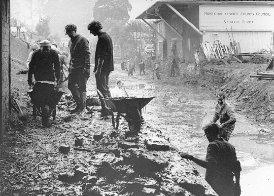
As most readers will know, HRH Prince Charles as Chairman of the Prince of Wales Committee has personally announced its first major action. Briefly this is to arrange for financial support from members of the Variety Club of Great Britain to enable seven miles of the Montgomery Canal to be restored as quickly as possible in the area of Welshpool. This stretch runs from the dropped road bridge at Gallows Tree Bank to Four Crosses and includes six locks, four at Pool Quay and two at Burgeddin. Our initial intention is to start towpath clearance from Pool Quay top lock and work towards Four Crosses. In view of the amount of work involved, working parties will be held on one day in each weekend.
Town Lock was reopened by the then Prince of Wales (now King Charles III) on 23 May 1974. Work continued on the rest of the seven miles, SUCS moved to Carreghofa then Burgedin Locks, IWA and WRG took on Frankton to Queen’s Head then Aston Locks, and restoration has progressed to the stage it is at today - see pages 10-13 and 24-25.
If the Montgomery reopening involved a relatively modest length of waterway, the Upper section of the Warwickshire Avon was a different matter.
Following the rescue from dereliction of the Lower Avon from the junction with the Severn at Tewkesbury to Evesham and the complete restoration of the southern length of the Stratford-upon-Avon Canal both completed in 1964, the logical next step was to restore the Upper Avon from Evesham to Stratford, linking these two completed schemes together and (in combination with the Severn, the Worcester & Birmingham Canal and the northern Stratford Canal) creating an ‘Avon Ring’ circuit of waterways.
The trouble was, the Upper Avon had been closed for much longer than anything that had been restored to date: it hadn’t seen any sizeable boats or any maintenance since around the 1870s. Not only were the locks in a state of ruin, but since they had been abandoned the water levels in the river had fallen (and modern water authorities were very much against allowing them to be raised to the former navigable levels - in some places they insisted on levels being lowered even further) so even if restored the locks would be at the wrong height.
The ‘restoration’ was therefore more a case of creating a new navigation on a formerly-navigable river. Masterminded by David Hutchings, the project saw a whole series of brand new locks built, in unashamedly modern style with steel piled chambers and steel
gates, and on different sites from the originals.
By using prison volunteers, bringing in the Army with explosives, negotiating with local landowners for the lock sites, and some unorthodox construction methods, ‘Hutch’ had got six locks built and the first section of river above Evesham open in 1971.

By February of our ‘glorious year’ 1974, work was heading towards completion, but there was still plenty to do, as David Hutchings reported in Navvies …
There seems a good chance that we shall be open for the coming season. On the river itself we have just completed the building of a new wharf; by doing this we have earned enough money to pay our share of the last (geographically) operation on the navigation, ie the heavy dredging and protection between the new lock and the old railway bridge at Stratford. In this matter the River Authority and the Borough are each paying a share of the costs and by using our methods we have reduced the total from about £60,000 to about £25,000. The work started last Wednesday 23rd January, and is going well. Neither the wharf job nor the present one could have been undertaken were it not for the very efficient help we have received from your volunteers at the weekends, I really do mean this for we have no Borstal or prison labour. Perhaps you would convey our thanks to all those who have helped.
Before the opening, which we hope will take place in June, we have to finish the job in Stratford which will take about two months (normally it would be 6/7 months), carry out some heavy bank protection and dredging at Luddington where we have suffered bank erosion, build four new landing stages at Weir Brake, carry out various improvements at locks probably re-dredge some of the lock cuts, and have everything painted, greased and mown ready for the season. We shall therefore require help every weekend from now until Midsummer and probably beyond.
Meanwhile Nigel Stevens was urging London Working Party Group (London WRG’s forerunner) to support work at Stratford every weekend, helping with piling and building a wall below “Mr Hutchings’ Monstrous Erection” (the new Stratford Lock - see page 16) so that the channel could be safely deepened without the bank collapsing. “More volunteers (from anywhere) are urgently needed to get the river finished on time” as he put it.
By the April edition there was a slight air of desperation to Nigel’s appeal… ALL GROUPS URGENT UPPER AVON: Your help is urgently needed. Ten years ago, when the Queen Mother reopened the Stratford Canal, she promised that she would one day return to open the Upper Avon. That date is fixed at last: the 1st of June just two short months away.
But if the river is to be ready for traffic, a fantastic amount of work needs to be doneheavy bank protection and dredging, building landing stages, planting trees, and much maintenance and improvement all before that much-photographed bank of earth can be removed to let the boats through! As you know, there are no longer any prisoners on the
river, so that David Hutchings depends entirely on weekend volunteers to get the work done. He has therefore, asked us to provide a group of at least six volunteers every weekend…
If every regular London navvy (and new ones too) makes the effort to come once, we shall be able to present the world with a perfectly finished navigation on the 1st June. If not, boats - and in consequence the whole restoration movement - will be in trouble.
In the June issue editor Graham Palmer simply mentioned that by the time it appeared in print, the opening would have happened, and thanked all the volunteers for their contribution to what “hasn’t been a glory job and all too often one of sheer hard work”but one which had been finished on time and within budget. The following issue confirmed that it had indeed opened on 1 June, with fulsome thanks from David Hutchings and Robert Aickman, Uper Avon Navigation Trust Chairman (and IWA founder in an earlier era).
The next opening was another rather smaller one - but as with the Montgomery, an important step towards a major reopening. When the Kennet & Avon fell derelict and became unnavigable in stages in the 1950s, a few lengths remained open. One was the Bristol Avon section from Bath to Bristol, another was a short length of the Kennet from the Reading end, and a third was a short isolated length around Newbury. This shrank down to the point where it was only a couple of miles and the odd lock, but then when the restoration got under way it was gradually increased by reopening locks westward to Kintbury and beyond.
The July 1974 opening at Hungerford Lock marked the completion of the four miles and four locks west from Kintbury to Hungerford, and meant that Newbury and Hungerford were once again connected by a significant length of restored canal. You won’t find anything about it in Navvies at the time (it wasn’t a volunteer project), but you will find plenty of work going on elsewhere along the route. The Kennet & Avon Canal Trust’s Bath & Bristol group were working at Bath and Claverton Pumping Station, as well as the locks on the Kennet section plus a ‘junior’ group clearing side ponds at Caen Hill Locks, Devizes.
And a project was just getting under way which would in due course link up with Hungerford…
British Waterways Board have asked the K&A Trust to fully restore the Crofton flight of nine locks (with the exception of fitting lock gates) using volunteer labour. It is hoped that this ‘test’ will lead to other sections of BWB canals being given the same treatment in due course. Plans to cope with this unexpected ‘bonus’ are being prepared.
London Working Party Group were urging their volunteers to support this project as the volunteers would have their work cut out to get the locks ready for when the gates were due to arrive in 1976.
Unfortunately the vision of this being a pilot for more volunteer restoration taking part on British Waterways canals was not to happen. Trade union opposition (or quite possibly, BWB management inventing such opposition - “We’d love to have you, but the unions would never stand for it” - as a way of avoiding the inconvenience of having volunteers on its waterways) led to
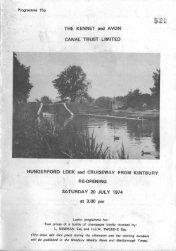
Souvenir programme from the Hungerford opening
a near moratorium on volunteer restoration work on BWB sites, both on the Kennet & Avon and elsewhere. Indeed the K&A Canal Trust’s own teams ended up working on other nonBWB canals - such as the Basingstoke.
But meanwhile the remainder of the K&A was restored largely using professional contractors, and reopened throughout in 1990.
The final opening was on the Caldon Canal, where the eastern eight miles and eight locks from Hazelhurst (junction with the still navigable Leek Arm, needed for its important water supply function for the Trent & Mersey Canal) to the Froghall terminus had fallen into dereliction at the start of the 1960s. Ten years later, the Caldon Canal Society was pushing for restoration, and in 1972 they reported in Navvies that the agreement to restore it between BWB, Staffordshire County and Stoke City councils was about to be signed - or as they put it, “We are assured that it is purely a matter of writing it up in the correct unintelligible legal jargon”.
This was an early example of the concept of a canal as a ‘linear park’. Its value as a local amenity for walkers was an important factor in getting the local authorities to support it, and a lot of CCS’s voluntary contribution would be in restoring the towpath - along with lock chamber and bridge hole clearance.
By summer 1974 CCS’s Navvies report gave a good impression of a canal and towpath nearing completion…
The Caldon has not been fully reopened yet, neither formally (i.e. a ceremony), nor in terms of boat traffic being able to reach Froghall. Based on my own observation of the way things are going, I would say it may well be open for boat traffic throughout by 1st July, or 1st August at the latest. At the time of writing, BWB are completing dredging work on the Consall Forge - Froghall section, and contractors should just about have completed the work on Froghall Tunnel, which has been stanked-off for a month or two now. Boat traffic can now reach the head of Consall Lock No 16 and this has been the case since Easter.
An Inspector of the Froghall-Denford section of the canal together with Mr. Haskins, Mr. Platt and Mr. Berkeley of BWB was made in late March. One representative each from

Caldon Canal reopening at Cheddleton in September 1974…
Staffs. County Council, and Stoke-on-Trent Corporation were also present, whilst the Caldon Canal Society were represented by Gordon Myatt (the Chairman) and myself. It was agreed by Brian Haskins that we had completed most of our share of the restoration work, but I suppose it will take us about a further 6-12 months from now to complete properly all the works on the schedule we were given by BWB at the commencement of the restoration programme just over two years ago.
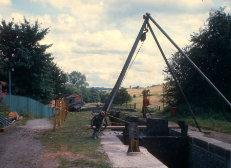
We have managed to keep in front of the dredgers throughout, so that the canalside vegetation was neatly trimmed back to the shoreline on both sides, with towpath cleared too. What remains are mostly hedges which have had their towpath sides brushed, but which still require topping and particularly on the Churnet River section a large number of trees which require climbing and branches lopping off…
Whether or not the writer’s guess at 1 July or 1 August for boat traffic getting to Froghall proved to be correct, it was certainly open by 28 September when an official ceremony took place at Cheddleton.
So that concludes the glorious year of canal reopenings in 1974. Shall we see its like again?

…and a 40th anniversary commemoration event with some of the same people present in 2014
The last six pages (and part 1 in issue 324) recall 1974, the glorious year of waterway reopenings. Here’s a report from someone who was there…
As I write this it’s the 1st of June. 50 years ago today the Queen Mother opened the Upper Avon Navigation at Stratford on Avon.
As a 17 year old I had been going to help on the Avon a couple of weekends per month leading up to the opening (probably to the detriment of my “A” levels) with a small group of Londoners.
Whit week came and my family had taken our boat to Stratford to attend the opening and I continued to help with the finishing touches. One of most memorable of these being laying the turves on the slopes just below Stratford new lock. They kept slipping off into the water as the bank was so steep, so David Hutchings the boss, ever the most practical person, told us to nail them to the bank with 6-inch nails! It worked a treat!
On the day of the opening we could do no more, so I watched the displays being corralled in the Memorial Theatre car park. As the Army had helped with some of the restoration the Royal Engineers brought some of their plant to display, which was absolutely pristine and spotless, to the point that they were going round after it had been unloaded and put into position with cans of paint to touch up the tracks. On the other side of the car park was the Upper Avon Navigation Trust plant and equipment which was very much in the “as used” condition, including one of WRG’s Smalley 5 diggers that had been borrowed for a bit of last minute dredging but had managed to fall off the mud boat into the river and been retrieved by crane, definitely looking worse for wear.
The various volunteers all met up at the One Elm pub at lunchtime - our job being completed - to relax and swap tales, when all of a sudden John Felix, one of the senior figures in WRG at the time realised what the time was and pointed to me and few others, threw a WRG tee shirt at us, saying “put that on and get in the van”. He apparently had

been detailed to organise a party of representative volunteers for the lineup..
So we jumped in the van and unloaded into a trip boat at Lucy’s Mill and watched Queen Elizabeth the Queen Mother rise up through the lock which locally had been nicknamed “Mr Hutchings’ Monstrous Erection”, due to the beams installed over the top to stop the sides caving in. After the speeches and ribbon cutting we all processed in our boats up the river to the Theatre where we volunteers were lined up in front of the Smalley and were met by WRG leader Graham Palmer and Nigel Stevens from London WRG, who had been in the Royal party – in suits!! They were almost unrecognisable to us red tee shirt gang, who only knew them in their navvy gear. We were duly inspected by Her Majesty accompanied by David Hutchings, a very proud moment for us all.

A few weeks later there was, as part of a series on BBC2, a programme called One Man’s Week, and this particular episode featured David Hutchings and the week leading up to the opening. I watched this programme eagerly hoping for a glimpse of us volunteers at work, which there may have been in the distance. As the credits at the end of the programme rolled there was a close up of a Waterway Recovery Group tee shirt and, as the camera zoomed out, a beaming face of yours truly was there for the world to see! My 15 seconds of fame, along with a fantastic feeling of achievement. This is one reason why we in WRG do what we do and I hope that any of you youngsters reading this will have similar memories that stay with you 50 years in the future.
Nick Wright
In putting together the piece about 1974 the editor came across the following …
“The canals are of tremendous importance in the development of leisure facilities as a whole… I believe that we ought not to be closing canals but opening many more and even building new ones… I have made it clear to the authorities that it would seem to make more sense to dig canals, to transport water through canals which can be used for other purposes like boating and angling…”
- Denis Howell MP, Minister for Sport, 1974
The above quote from Roger Squires’ book Canals Revived shows that at least some in positions of power were coming around to our way of thinking. But the news story from East London’s Stratford Express reproduced in Navvies 49, which followed a tragic death of a child in a local drainage channel, and called for all unneeded waterways to be filled in, and all necessary ones to be fenced in “and made inaccessible for children” shows there was some way to go. Have we moved on since then? Or, given their reluctance to provide future public funding to keep the existing network open, let alone to expand it, are today’s Defra ministers actually way behind Mr Howell in their support for canals?

CanalCampscost£80orasstated.BookingforWRGCampswithnumber(egCamp AsheridgeRoad,CheshamHP52PX.Tel:01494783453,enquiries@wrg.org.uk.Diary
Jun22-23 London WRG BuckinghamArm:TrenchdiggingforchargerforB&MKtripboat
Jun22-23 wrgBITM WessexWaterways:Dauntsey,spillweirrepairandBITMtoolmaintenance
Jun29-Jul6 WRG CC2024-03 Wey&ArunCanalCamp:RooksBridge(NWPG).Leaders:BillNicholson/GrahamHawkes, Jul5-18 WAT WendoverArm:provisionaldates
Jul7-14 WRG CC2024-04 Manchester,Bolton&BuryCanal(week1)CAMPCANCELLED-Seepage5
Jul6-13 WRG CC2024-05 Wey&ArunCanal:RooksBridge(KESCRG).Leaders:EdWalker/StephenDavis,cook:Eli
Jul14-20 WRG CC2024-06 Manchester,Bolton&BuryCanal(week2)CAMPCANCELLED-Seepage5
Jul20-21 wrgBITM CotswoldCanals:Tobeconfirmed.WesternEnd,prepfor3weeksofcamps
Jul20-27
WRG CC2024-07 CromfordCanal.Leaders:Dave‘Moose’Hearnden/PeteFleming,cook:MariaHearnden
Jul27-Aug3 WRG CC2024-08 LichfieldCanal(week1).Leaders:ColinHobbs/WilliamMatthew,cook:SteveWyatt
Jul27-Aug3 WRG CC2024-09 CotswoldCanals:JohnRobinsonLock(week1).Leaders:MikePalmer/BeckyParr,cook:Mitch
Aug2-15 WAT WendoverArm:provisionaldates
Aug3-10
WRG CC2024-10 LichfieldCanal(week2).Leaders:ColinHobbs/JaniceChambers,cook:MatthewRogers Aug3-10
WRG CC2024-11 CotswoldCanals:JohnRobinsonLock(week2).Leaders:RuthHarden/WillRadice-Horne, Aug10-17 WRG CC2024-12 LouthNavigation.
Aug10-17 WRG CC2024-13 CotswoldCanals:JohnRobinsonLock(week3)
Aug17-24
WRG CC2024-14 LapalCanal.Leaders:Dave‘Evvo’Evans/PaulHarrowsmith,cook:IanJohnson
Aug17-24 WRG CC2024-15 CotswoldCanals:WeymoorBridge(week1)
Aug17-18 wrgBITM SuffolkStour:Carparkresurfacing,fishingpointremoval,etc
Sep21-22
Aug24-31
MBBCS
WRG CC2024-16
Manchester,Bolton&BuryCanal:NobEndLocks
Wey&ArunCanal:BonfireHangerTowpath(week1)
Aug24-31 WRG CC2024-17 CotswoldCanals:WeymoorBridge(week2).Leaders:StephenRice/SandraHorner,cook: Aug31-Sep7 WRG CC2024-18 Wey&ArunCanal:BonfireHangerTowpath(week2)
Sep6-19 WAT
Sep7-8
WendoverArm:provisionaldates
London WRG CotswoldCanals:jointworkingpartywithKESCRGatWeymoorBridge
Sep7-8 KESCRG CotswoldCanals:jointworkingpartywithLondonWRGatWeymoorBridge
Sep21-22 wrgBITM MaidenheadWaterways:BrayCut
Sep29Sun WRG
Oct4-17 WAT
WRGCommittee/BoardMeeting:10:00amatRowingtonVillageHall
WendoverArm:provisionaldates
Oct5-6 London WRG Shrewsbury&NewportCanals
Oct5-6 KESCRG Tobearranged
Oct19-26 WRG CC2024-19 CoombeswoodCanal.Leaders:NigelLee/Dave‘Evvo’Evans,cook:AnneLilliman
Oct19-20 MBBCS Manchester,Bolton&BuryCanal:NobEndLocks
Nov2-3 WRG
Nov2-3 KESCRG
Reunion(‘BonfireBash’)majorworkingparty:venuewanted!
SupportingWRGReunion
Nov2-3 London WRG SupportingWRGReunion
Nov16-17 MBBCS
Nov16-17 wrgBITM
Dec7-8 KESCRG
Dec7-8 London WRG
Dec6-19 WAT
Manchester,Bolton&BuryCanal:NobEndLocks
MaidenheadWaterways:BrayCut
Wey&ArunCanal:ChristmasworkingpartywithLondonWRG
Wey&ArunCanal:ChristmasworkingpartywithKESCRG
WendoverArm:provisionaldates
Dec14-15 wrgBITM Tobearranged
Dec21-22 MBBCS
Manchester,Bolton&BuryCanal:NobEndLocks
Dec26-Jan1 WRG CC2024-20 Christmas/NewYearCanalCamp:BuckinghamCanal.Leaders:Dave‘Moose’Hearndenand
CC2024-03)shouldgoto:WRGCanalCamps,Unit16B,FirstFloor,ChilternCourt, DiarycontributionstoDaveWedd,Tel07816175454mdave.wedd@wrgbitm.org.uk
Tim Lewis
Hawkes,cook:SuWebster
07802-518094 london@wrg.org.uk
Dave Wedd 07816-175454 dave.wedd@wrgbitm.org.uk
01494-783453 enquiries@wrg.org.uk
Ken Palfrey volunteer@wendovercanal.org.uk 01494-783453 enquiries@wrg.org.uk
EliMathieson 01494-783453 enquiries@wrg.org.uk 01494-783453 enquiries@wrg.org.uk
Dave Wedd 07816-175454 dave.wedd@wrgbitm.org.uk 01494-783453 enquiries@wrg.org.uk 01494-783453 enquiries@wrg.org.uk
MitchGozna 01494-783453 enquiries@wrg.org.uk
Ken Palfrey volunteer@wendovercanal.org.uk 01494-783453 enquiries@wrg.org.uk
Radice-Horne,cook:BevWilliams
01494-783453 enquiries@wrg.org.uk 01494-783453 enquiries@wrg.org.uk 01494-783453 enquiries@wrg.org.uk 01494-783453 enquiries@wrg.org.uk 01494-783453 enquiries@wrg.org.uk
Dave Wedd 07816-175454 dave.wedd@wrgbitm.org.uk
Sam Kennion 07843-394161 samklancs@yahoo.com 01494-783453 enquiries@wrg.org.uk
cook:LouKellet 01494-783453 enquiries@wrg.org.uk 01494-783453 enquiries@wrg.org.uk
Ken Palfrey volunteer@wendovercanal.org.uk
Tim Lewis 07802-518094 london@wrg.org.uk
Ed Walker 07887-568029 ed@edwalker.eclipse.co.uk
Dave Wedd 07816-175454 dave.wedd@wrgbitm.org.uk
Mike Palmer mike.palmer@wrg.org.uk
Ken Palfrey volunteer@wendovercanal.org.uk
Tim Lewis 07802-518094 london@wrg.org.uk
Ed Walker
07887-568029 ed@edwalker.eclipse.co.uk 01494-783453 enquiries@wrg.org.uk
Sam Kennion 07843-394161 samklancs@yahoo.com 01494-783453 enquiries@wrg.org.uk
Ed Walker 07887-568029 ed@edwalker.eclipse.co.uk
Tim Lewis 07802-518094 london@wrg.org.uk
Sam Kennion 07843-394161 samklancs@yahoo.com
Dave Wedd 07816-175454 dave.wedd@wrgbitm.org.uk
Ed Walker 07887-568029 ed@edwalker.eclipse.co.uk
Tim Lewis 07802-518094 london@wrg.org.uk
Ken Palfrey volunteer@wendovercanal.org.uk
Dave Wedd 07816-175454 dave.wedd@wrgbitm.org.uk
Sam Kennion 07843-394161 samklancs@yahoo.com andNigelLee,cook:MariaHearnden 01494-783453 enquiries@wrg.org.uk
Work is under way to extend the restored length of the Chesterfield Canal eastwards from Staveley, thanks to a Towns Fund grant
Chesterfield Canal: Staveley Town Deal project
The Chesterfield Canal Trust recently celebrated the start of its latest phase of restoration with a groundbreaking ceremony for the Staveley Town Deal project at Staveley.
Spring had been a busy period for the project to extend the Chesterfield to Staveley restored length eastwards, though without any actual construction work under way. However, that was all about to change.
At the latest Project Board meeting, final authorisation was given to commence construction. This meant that all final planning conditions have now been discharged and all of the necessary access licences are in place. The Trust’s contractor, O’Brien Contractors Ltd, moved onto site on 15th April. The initial phase is establishing the construction compound, creating the temporary footpath diversions and starting on some of the minor earthworks. The most visible work was due to begin in June, when the new bridge carrying the Trans Pennine Trail would start in earnest.
Talking of the bridge, we can now confirm that we have selected the ‘Pearl Orange’ colour, the clear winner over the black and grey option in lots of feedback on social media and directly from stakeholders.
Following construction of the abutments for the new bridge by contractors O’Brien’s, this 38 metre long structure is due to be lowered into place in September.
We’ve also been thinking a lot about lock gates for the new lock due to be built. There are very limited suppliers, and the costs of lock gates have consequently gone up a lot since our original budget was set. We are in final negotiations with a potential supplier and
Length: 46 miles (26 miles stayed open, 12 miles restored, 8 miles left to restore
Locks: originally 65; 2 added during restoration, more needed
Date closed: between 1907 (end of through traffic, Norwood Tunnel collapsed) and 1961 (officially abandoned)
Staveley to Chesterfield
restored: 6 miles 6 locks (including new Staveley Town Lock)
Worksop to Kiveton restored and reopened in 2002: 6 miles 31 locks (including 12 extra added)
Section being restored with Staveley Town Deal grant
Kiveton to Staveley unnavigable ‘missing link’ including current restoration sites: 8 miles 14 locks (originally) diversions needed at Killamarsh and Norwood Tunnel
West Stockwith to Worksop saved from closure in 1960s: 26 miles 16 locks
hope to be able to make a firm commitment soon.
The increased price of the gates is a key reason for the Trust launching the ‘Keith Ayling Lock Gates Appeal’ in December last year. Keith was Chair of the Chesterfield Canal Trust from 1991 to 2009, was influential in all of the work achieved during that time, and provided the foundation for all of the work underway today. The new lock will be his permanent memorial. The Trust is targeting raising £50,000 towards the cost of the gates, and you can find more detail about how to support the appeal on our website.
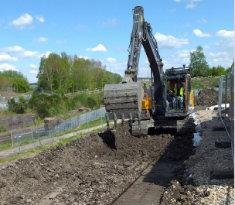
Initial footpath diversion work under way at Staveley
Meanwhile there has still been a lot going on in the background for the main works as the final design and permissions were completed. In the next issue we hope to have pictures of the major work getting under way.
The project, supported by £5.8m from the Staveley Town Deal fund, will recreate a missing length of canal extending eastwards from Hartington Harbour, Staveley, onto the start of a major clay embankment called the Puddle Bank which crosses the Doe Lea Valley. The work will involve extensive earthworks to counter mining subsidence, construction of another new lock to return the canal to its original level, and two new bridges – one to carry the Trans Pennine Trail and the other to carry a farm vehicle access track.
In addition the towpath will be upgraded to a multi-user trail, stretching all the way across the Doe Lea Valley to Renishaw. Finally, the whole area will be planted with wildlife friendly vegetation and a seating area for people to enjoy the newly restored canal will be installed.
While 26 miles of the Chesterfield Canal from the Trent at West Stockwith to Worksop remained open, the 20 miles west from Worksop to Chesterfield were abandoned. Restoration of this derelict length has mainly concentrated on two sections…
An isolated five mile length of the Chesterfield Canal has been restored and reopened to trailable craft, descending north eastwards from Chesterfield via five locks to a new basin at Staveley. This has been extended via a new sixth lock (Staveley Town Lock) east of the basin, leading to a length christened Hartington Harbour, beyond which the canal has disappeared for some distance.
Meanwhile a six mile length from the existing limit of navigation at Worksop to the eastern portal of Norwood Tunnel at Kiveton was restored and reopened in 2002.
That leaves a ‘missing link’between Staveley and Kiveton of less than nine miles to be restore. The Staveley Town Deal project will reinstate just over half a mile of canal at the western end of this gap, leaving just under eight miles to go (albeit eight tricky miles, with the collapsed Norwood Tunnel and a section that has disappeared under housing in Killamarsh) before the entire 46 mile route is complete again.
Shropshire Union Canal Society volunteers are continuing with channel and wharf wall rebuilding southwards from Crickheath
Montgomery Canal: Crickheath South work party - May 3-6, 2024
Success! Shropshire Union Canal Society’s volunteers finally managed to access the Crickheath tramway wharf wall area and, in good weather, made substantial progress elsewhere on the ‘Crickheath South’ section leading southwards from the new head of navigation (since the 2023 reopening) at Crickheath towards the new Schoolhouse Bridge (see map on page 10).
The May work party was extended to four days to include bank holiday Monday. Although Monday was mainly given over to cleaning, tidying and various preparations for next time, this did allow for three very full days of activities on site with high numbers attending. Work continued with lining the channel and blocking (laying concrete blocks on top of the lining to protect it) – a further 30 metres was completed. For the entire 90 metres length that is now lined and blocked, rip-rap (medium-sized aggregate) was placed over the liner on the towpath bank. This will be covered with soil at a later date. Work continued to profile the channel in readiness for lining and blocking at future work parties. The area south of the compound is now almost complete.
In the same area on the offside bank, a start was made to install the retaining wall to create the ‘soft bank’. This is achieved with two courses of specialised, interlocking hollow concrete blocks. No mortar is used and the blocks must be carefully positioned and level for the interlocking to produce a robust result. A very satisfying 43 metres of the first course was carefully laid. The first course needs to be filled with earth within the blocks and
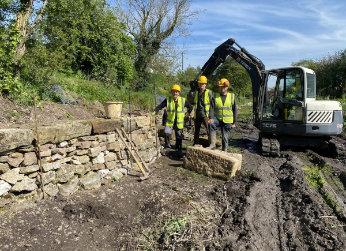
Despite muddy conditions the walling team can add coping stones to the tramway wharf
by SUCS
immediately behind before the second course can be laid but the picture below gives an idea of how the interlocking works. When complete, both courses will be below water level and the area behind filled with earth fully covering the liners. This creates a deep, soil bank encouraging a diverse range of water margin plants whilst still minimising the risk of bank erosion.
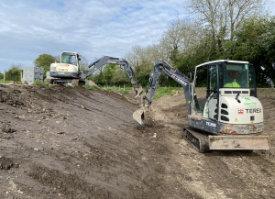
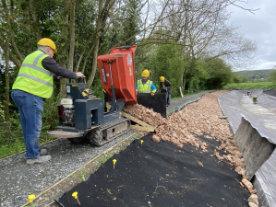
Due to the exceptionally wet winter this year, it has been a struggle to drain the northern section of the site by the former tramway wharf. Last month’s attempt, using six different pumps, proved unsuccessful so before this work party, a large 165 cubic metre per hour industrial pump was installed to clear the channel and allow access. This worked! Our existing submersible pumps are now keeping up with the continuing inflow of ground water. With access now possible, albeit extremely muddy in the centre of the channel, it was possible to restart work on the wharf wall. The wall itself has now been repaired so the next task is to place coping stones back on the top. These are large and heavy and lifted by machine. Where possible, we are reusing the existing copings although a number are no longer serviceable and new, hand tooled replacements have been sourced. This time, existing, somewhat irregular, copings were used including around a tricky corner. This takes considerable time, effort and skill to ensure they are stable and level but after 3 days 14.3 metres had been completed. Thanks as ever to members of the Dry Stone Walling Association for their assistance with this.
Meanwhile the Shrewsbury & Newport Canals Trust are re-homing a historic shed, reclaiming remains of a liftbridge, and digging drains
Shrewsbury & Newport Canals Trust’s work on the S&N is going well now that the weather does at least seem to be drying up –at long last!

At Wappenshall, where our plan is to create a canal centre and community centre in the historic warehouses where our two canals (the Shrewsbury Canal and the Newport Arm of the Shropshire Union Canal) met, the Romney Building (big green shed) that was erected in 1944 as a dry foods storage facility for the RAF and USAF Training Units in Shropshire was carefully dismantled in early March and transported to our partner organisation at Ironbridge Gorge Museum Trust. There it will be re-built and used as a Heritage Machinery workshop and storage. This has made a huge difference to the appearance of the place because it looks so much bigger now. (See photo, above).
The huge amount of groundwork that is required, complete with new drainage and surface water discharge, is now underway. (See photo, right). We hope to hear some good news from the Local Authority about our overall drainage plan, which will allow us to complete the job. The opening of the café in the
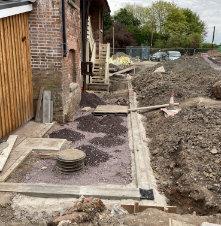

warehouse buildings will depend on this.
The third picture (above) is the lift bridge site at Rodington. Most of the bridge’s original metal parts have been recovered when the bridge hole was dug out. The brickwork and stonework, although partially demolished, is mostly there too. So, plans are afoot to rebuild the bridge, which will clearly show that the Shrewsbury Canal is under restoration.
After a visit from the London WRG for a weekend in February, the approach to the south portal of the Berwick Tunnel is really starting to look like a canal again. (see photo, right).
We also benefited from some excavator training supplied by WRG’s Paul Shaw at a session shortly afterwards. So, we now can crack on to get this section dredged. Anyone know of a suitable boat we might be able to borrow to put our JCB onto?
Bernie Jones
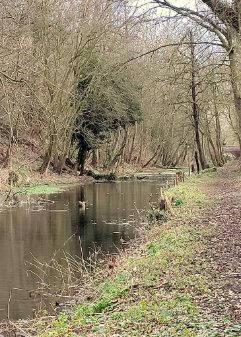
Following on from the completion of Woolsthorpe Lock 14, the Grantham Canal Trust is pressing on with Lock 13 - just one more to go!
The refurbishment of Lock 13 of the Grantham Canal builds on the rebuilding and repair work carried out (and supported by WRG Canal Camps) on Locks 14 and 15 over the last four years. It will, when completed, be the sixth lock brought back into use in the Woolsthorpe flight of seven locks.
The construction work is being carried out by Grantham Canal Society’s volunteer labour force who devote their time and energy to bring back to life the working of a canal that was originally completed in 1797. The Grantham Canal is 33 miles long and runs from the River Trent to Grantham and, in its time, transported goods (including coal) into the villages in the Vale of Belvoir, culminating at its ultimate destination in Grantham.
We now have over five miles of restored navigable waterway from Lock 14 at Stenwith / Woolsthorpe all the way to the A1 at Grantham, where the road embankment blocks the canal, cutting off the final length which led to the town terminus. Getting under the A1 will be another target; meanwhile at the other end of the canal, so will getting a connection to the River Trent. This will be a challenge, as the original route has been lost under road development on the south east side of Nottingham, but will open the waterway to canal boat navigation from the rest of the waterways network.
It will be a lot of work to achieve this aim, particularly with bridges to be reinstated and silt to be removed, but we have a vision that one day it will be achieved!
We are currently restoring Lock 13, which will entail civil engineering work and water management, as well as looking after the ecology and biodiversity. Overall cost will be in the region of £250k phased over two years.
Length: 33 Locks: 18 Date closed: 1936
The Grantham Canal was opened in 1797 and ran for 33 miles from the Trent in Nottingham to Grantham via 18 locks built to take boats 75ft by 14ft. It was sold to a railway in 1854 after which trade declined, ended in 1929 and the canal shut in 1936. Many bridges were demolished in the 1950s but the channel survived largely intact apart from a length in Nottingham which disappeared under a 1970s major road scheme.
River Trent To Shardlow To Newark
Proposed diversion via Polser Brook
Original route obstructed
Restored length including locks 7 and 8
Lock 13: restoration work starting

Locks 14-18 restored
The Long Pound: 20 miles with no locks
Restored and navigable Woolsthorpe to A1
The two locks we have completed have given our volunteers skills in building and civil engineering work that they never thought they would achieve. At the present time we are in the early stages of refurbishment but will be into expenditure with the introduction of a propping system to support the walls when working in the lock chamber (£25k), an anchor system to tie back the wall structure (£28k), and overall repairs to the masonry (£75k), before the lock gates are installed towards the end of the project (£95k).
Once this project is complete, it will only leave Lock 12 at Stenwith to be restored to complete the Woolsthorpe flight. This will then enable opening up of the canal at a level height all the way to Cropwell Bishop at Lock 11 some 20 miles away through the Vale of Belvoir.
Currently the busy season for the Grantham Canal Society is well underway, and volunteer work parties have been making good progress on maintenance and restoration projects. Volunteers have attended chainsaw training to allow them to clear self-set trees along the

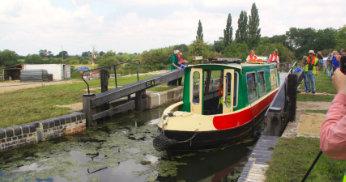
canal bank, as these trees can block the towpath or canal, threaten the structure of the canal bank or become unstable if not removed. Lock 16 has had a fresh lick of paint and initial work on Lock 13 is well underway. A dam and an overflow by-wash are being constructed so that the lock can be drained and inspected, ready for refurbishment to commence.
The society has a small fleet of working boats on the navigable section of the canal from Woolsthorpe Locks to the A1, and skilled volunteers keep them in working order. The Three Shires, the society’s trip boat, also had a freshen up ahead of its Easter boat trips. The weekend was a huge success, with trips selling out on Good Friday and Easter Monday. The Three Shires generates crucial income for the society to continue its work. To find out more about the award-winning short trips and longer cruises, please visit: granthamcanal.org/trip-boat24
Meanwhile lots of post-winter tidying up and organising has been ongoing at the Society’s depot, making sure GCS is ready to welcome visitors on open days. The Events Team have put together a fantastic calendar of Sunday events: by the time you read this there will have been a Craft Fair on April 21st and cream teas on June 9th, while for the summer an Activities Day is planned on August 11th and a Produce Fair (as part of Lincolnshire Heritage Open Days) on September 15th. All of these events are to be held at the Grantham Canal Society Depot, NG32 1NY, 10am-3pm. More information can be found on the Society’s Facebook and Instagram pages.
If you would like to find out more about how you can be involved with the society’s work, either in work parties or behind the scenes, GCS would be delighted to hear from you. They are particularly looking for help with fundraising, marketing, education, graphic design and scriptwriting, but everyone is very welcome! Please email our Volunteer Coordinator, Mark at volunteer@granthamcanal.org.
Nikyla Manners
Tony Osbond
See granthamcanal.org for more


An official reopening marks the completion and rewatering of a length east of Lichfield - and the latest chapter in a story going back 30 years
On 12 April an official opening marked the completion of the Lichfield & Hatherton Canals Restoration Trust's Darnford Moors Ecology Park project - incorporating the restoration of an important 600 metre length of the Lichfield Canal.
This section, running between Darnford Lane and Cappers Lane, towards the eastern end of the canal between Lichfield city and where it used to meet the Coventry Canal at Huddlesford Junction, will be familiar to many Navvies readers. Not only was it the site of Waterway Recovery Group's two weeks of Lichfield Canal Camps in 2023, but it has seen volunteer work by WRG and other visiting mobile groups going right back to the 1990s, when we worked on the abutments for the Darnford Lane liftbridge, rebuilding a culvert carrying a brook under the canal, piling the channel sides, and a (sadly ill-fated) attempt to line a trial length of the canal and enable it to be rewatered.
Ill-fated? Many volunteers who've worked on the site will recall the dry, red, dusty, sandy soil that blew around when it was windy, turning the site into a bit of a dust bowl. Well, this is also very porous and means that the canal needs a good waterproof lining. And unfortunately the early work in 2000 struggled to get a watertight seal between the piling and the
bentonite clay matting that was being used as a watertight lining on a trial length of channel reinstated in 2000. And so, rather than continue with the rest of the section, the project went on hold and the emphasis shifted elsewhere on the canal - to the successful projects at Tamworth Road Locks, Fosseway Heath, Gallows Wharf and more. But more recently thanks to development of a more successful design for the lining - and to funding grants secured from such unlikely sources as the HS2 railway's environmental remediation funds and the Biffa landfill operator - there has been a return to


Darnford. As you can guess from the name 'Darnford Moors Ecology Park' there's more to it than canal restoration, with new wetlands and other nature habitats created at the same time as a navigable channeland this has helped to secure the funding. Here's LHCRT's timeline for the site:
1994: The section closest to Darnford Lane was purchased by the Trust in 1994, financed by a loan from The Inland Waterways Association (IWA). This section is not on the original canal route, but forms part of a planned diversion to facilitate crossing Darnford Lane.
1995: The 250 yards of original canal closest to Cappers Lane was purchased by Lichfield District Council, financed by a Derelict Land Grant and licensed to the Trust.
1996: Aided by finance from the Manifold Trust and labour from WRG, a new concrete inverted siphon culvert was installed to take the Darnford Brook under the canal. Over 250 metres of sponsored piling was installed and a new nature reserve was created around the old lock 29 (which is bypassed by the canal diversion), by planting deciduous trees.
1997: A new lift bridge was installed by the Trust which allows the towpath to cross over from the south side of the canal to the north side. The bridge was repurposed from the Peak Forest Canal.
2000: Approximately 400 metres of sponsored piling was installed by WRG. Further on, the channel was constructed and graded.
2003: The planting of trees, wild flowers and English bluebells, together with our policy of protecting wildlife in the area, landed us the West Midlands Wildlife Trust's Conservation Award, Community Category for 2003. The award was sponsored by nPower and seeks to reward and publicise examples of good practice in nature conservation.
February 2022: The lift bridge was given a new lease of life thanks to Thomson Protective Coatings Ltd – all for free.
November 2022: We announced that a new section of canal, at the far end of Darnford Moors, would be built as part of the work to build HS2. The HS2 route clashes with our Cappers Lane Bridge built in 2005/6 using ERDF funding, so a new Cappers Lane bridge and a water-ready diverted canal will be built by Balfour Beatty Vinci, with completion due by 2028.
November 2022: Our volunteers cleared the site and carried out remedial work to the piling installed in 2000 while, behind the scenes, our funding volunteers were working on a huge bid for funding. Funding was secured for phase one and we were awarded
Length: 6 miles Locks: 30 Date closed: 1955
The Lichfield Canal is the name given by canal restorers to the disused 6 miles and 30 locks from Ogley to Huddlesford which formed the eastern end of the Wyrley & Essington Canal, part of the Birmingham Canal Navigations.
Newdeeplock 8planned
Newstream culvertbuilt Tunnelneeded underrailway
AngleseyBranch toAngleseyBasin
Lichfield Citycentre Motorway aqueduct Planned diversions Fosseway Heath
A461 A5
A38
EcologyPark
Darnford Lane
ToFradley
CoventryCanal
Lane ToCoventry OgleyJunction
A51
TamworthRoad
HS2 under construction
Wyrley&Essington CanaltoWolverhampton
£116,200 to create an ecology park, with The European Regional Development Fund (ERDF) providing £41,200 of the grant, and match funding of £75,000 from HS2’s Community and Environment Fund (CEF).
March 2023: Onsite Central Limited was the successful tenderer and was awarded the contract. Work started work on lining phase one with a geotextile lining with layers that are peeled back, so that the waterproof layers can bond together.
April 2023: By April a lot of work had been carried out on phase one and two; Onsite had almost completed the lining of phase one and volunteers moved 6,000 tonnes of soil from phase two, to profile and shape 350 metres of canal and towpath. We also announced that funding had been secured for phase two with a £250,000 grant from Biffa Award, as part of the Government’s Landfill Communities Fund.
July 2023: The canal held water for the first time in over 50 years. Contractor, Onsite Central Ltd completed phase one of the work and started water testing.
July 2023: A team from WRG installed ducting for electric cables which will power a pump to keep the canal section topped up. It will also eventually power charging points for electric boats.
November 2023: The Wesleyan Foundation’s Climate Action Grant awarded us funding to help towards the completion of Darnford Moors Ecology Park.
The grant enabled our visiting volunteer teams to create new footpaths, as well as enabling our main contractor to install waterproof lining materials in the final 100 metres.
April 2024: The completed and rewatered channel and associated nature reserves and footpaths were officially opened.
The next stages will be to build the bridge under Darnford Lane to the west (for which the concrete culvert sections have already been acquired and are standing in the canal channel adjacent to the bridge site), and to link up with the Huddlesford arm and through to the Coventry Canal to the east (once HS2 has completed work at Cappers Lane).

Next stage: use these culvert sections to create the new Darnford Lane Bridge
The WRG Leadership Teams Day (formerly the Leader Training Day) helps prepare leaders and cooks and give them confidence to lead Camps
The WRG Leadership Teams Day for 2024 took place on Saturday, 01 June at its traditional home of Rowington Village Hall near Warwick. It was a well-attended day of confirmed leaders for 2024, previous leaders still looking to lead this year and a few members of WRG Canal Camp hosting local canal societies. All eleven of the sites for this summer’s camps with confirmed leaders were represented.
WRG’s Chairman, Mike Palmer, welcomed everyone and reiterated the importance of this day for key messages to be passed to leadership teams from the WRG Board to give the leaders the confidence to run their camps, knowing they were capable and that they had the full support of the WRG Board. He said questions were always welcome and the exchange of ideas and thoughts by those present could only benefit everyone.
We enjoyed and learned from the following sessions / subjects:
HSE updates on the dangers:
• caused by vibration – Hand Arm Vibration Syndrome (HAVS) is more common and well known than Whole Body Vibration (WBV)
• working in cold and wintry conditions
WRG’s Annual Health and Safety Report was presented by WRG Director Dave (‘Moose’) Hearnden. He congratulated the leadership teams on their excellent work in keeping WRG camps relatively accident free. No serious accidents occurred in 2023 but more attention needed to be paid:
• when assembling, adjusting and dissembling scaffolding runs – scaffold tube is always heavier and more awkward to handle than thought, so operations need to be carefully planned and co-ordinated
• to the wearing of eye protection at all times, a WRG policy requirement
• to the writing of accident, incident and near-miss reports which needed to be more complete to give the reader the full details. Moose wondered if there needed to be more near-miss reports so as to allow the WRG Board to identify trends developing across different camps. For example: volunteers not wearing appropriate PPE for tasks should be considered a near-miss and, should this occur on a number of camps, perhaps more advice on how to prevent this would help leaders.
Other H+S topics considered were:
• the need to make sure the accommodation being used for camps had its appropriate safety certificates (eg: gas, electricity, etc)
• new and improved dust masks were being provided to protect volunteers and these were considered to provide better, although not complete, protection for volunteers with facial hair
• the fitting of chin straps to hard hats was discussed – they are available but not fitted to every hat because volunteers should not be leaning over far enough for their hats to come off
• the completeness of scrub-bashing (vegetation management) risk assessments.
WRG Sites Group – WRG Director George Rogers explained this group had recently been reformed to work with host societies to suggest where and when camps could be held and the extent of tasks and objectives, after which leadership teams would be selected to develop the way tasks would be conducted, make sure they had the volunteers with the required skills and then run the camps safely. The Sites Group would help leaders however
they could, especially supporting the leaders’ completion of camp paperwork.
Anonymised feedback supplied by volunteers on camps they had attended was reviewed. Most feedback was extremely complimentary but there were occasional comments which caused concern and which those present at LTD noted. For example:
• A few volunteers clearly lost motivation during their camps.
• Some wanted to be able to learn new skills on or before a camp.
Some examples of unexpected or unusual circumstances affecting some camps in 2023 were shared and discussed to help everyone. For example:
• How very small sites require more planning for the delivery of materials and sequence of tasks to get the work done efficiently. This also causes the work to need more time.
• Supply chain difficulties can delay work and sometimes mean objectives cannot be achieved through no fault of the volunteers but which can cause them frustrations and dissatisfaction.
Applications by volunteers to come on camps were discussed. Generally, the information required and provided was considered to be sufficient for leaders. However, some applications miss or lack important details (eg: about health, dietary requirements, allergies, etc) which leadership teams need to know.
It was felt that the conversations between leaders and volunteers during pre-camp telephone calls should indicate if there were inconsistencies in an application or reveal additional information essential for the well-being of volunteers and their enjoyment of the upcoming camp.
A cook on camp is considered the most important volunteer there! Cooks and their fellow leaders separated to consider the key ways of working together well and areas where this could be improved. Communication between the whole leadership team was considered

the most important factor for a successful relationship and camp. This would mean assistance for cooks would be provided when required, timings for meals would be known (and delayed when necessary), cleaning of accommodation would not be left to cooks and would mean that cooks would feel included at all times, despite being alone most of the time.
Motivation: a session was held to consider what is needed to keep volunteers and leadership teams motivated and, perhaps more importantly, how make sure demotivation does not occur. The findings of academic experts / commentators in this field were explained and then discussed.
It was agreed that WRG provides all the necessary factors said to be required to allow its volunteers to be fully motivated, once their own contributions were added to the mix. This would result in their keeping motivated and gaining later satisfaction from a successfully completed task.
Most commentators consider workplace motivation matters in respect of paid workplace employees but volunteers are different (although considered employees for H+S purposes) because extrinsic (external) factors such as pay, progression and other matters outside their control do not apply, so volunteers rely on intrinsic (internal) factors such as sense of achievement, recognition, responsibility and the actual work content, and reason for it, as their main driving forces, which have to be maintained or else demotivation could develop.
Allied to this is the need for criticism to be constructive and given in private while congratulation should be given publicly to build or maintain a volunteer’s self-esteem.
Other demotivating factors could be: lack of work, poor explanations, cliques, favouritism, poor preparation and not focussing on positives. Demotivation could be avoided by good communication, coaching volunteers, early interventions, alternate tasks being available / offered, fairness, etc. The main demotivating factors for leaders were considered to include accidents, unforeseen planning / organisational changes and deadline pressures.
Safeguarding: we were reminded of IWA / WRG’s Safeguarding policies and that at risk / vulnerable adults do come on camps and gain many benefits from being there. They also play full parts on camps – on site and in the accommodation. However, some volunteers are not known to be at risk before a camp so leadership teams need to be able to recognise the signs that they might be and act accordingly.
The last part of the afternoon was spent discussing what was needed to get the best out of 2024’s Canal Camps; subjects included:
• making sure the correct type of plant is supplied to prevent inefficiency in operations and even accidents
• identifying future members of leadership teams by chatting to competent volunteers about their taking on more responsibility and perhaps asking them to lead certain tasks within a camp
• pre-camp calls are important acts to allow leaders and volunteers to be as fully prepared as possible – perhaps a check-list / aide memoire would help leaders to to cover matters fully and easily
• how leaders might share useful information and how essential new information might be got to them quickly and efficiently – electronic methods seem to be the best way but there will be data protection issues to consider
Mike Palmer closed the day by thanking all those who attended, especially the cooks for the excellent meals provided, and by commenting that LTDs are an essential part of preparation for canal camps and that everyone learns something new. He was grateful for the suggestions made to benefit future camps and their planning which would be further considered and developed by the WRG Board.
MKP said the leadership teams approved by the WRG Board were very capable and had the full support of the Board which should give them confidence in themselves to run camps safely, successfully and enjoyably.
Dave ‘Evvo’ Evans
Independent mobile working party group Kescrg looks back on the last 12 months of working parties on a variety of sites mainly in the south
Kescrg – a year in the life of a visiting group
As we enter the summer WRG Canal Camp season, here is a look back on what has been a productive and interesting year of weekend digs for Kescrg Canal Restoration Group. We are a group of volunteers who lend our expertise, experience and enthusiasm to various canal trusts and projects around the southern half of England (and very occasionally Wales), running around 10 weekend digs through the year and providing the leadership team for a WRG Summer Camp.
Kescrg have been in existence since around 1977, initially focused purely on the Basingstoke Canal restoration, but soon diversifying to work on many different canals and projects. Our purpose is to organise dig weekends: liaising with trusts, nominating a leader for the weekend, hopefully enlisting a cook, ensuring logistics are in place for our tool trailer and sending out information and joining instructions to our mailing list and Facebook group.
We don’t have a membership as such; we welcome any volunteer who wants to join us, and we draw on a very similar pool of people to London WRG and WRG Forestry. We sort the weekends; you come and have a great time getting mucky with like-minded people! On any given weekend we usually have 8-15 volunteers, but across the year we have upwards of 30-40 individuals volunteer with us on at least one event.
We like to visit a variety of canals and sites over a year, often having one or two longer term projects which we will visit repeatedly as a focus, mixed with other work to keep things interesting and maintain relationships with the trusts and their volunteer coordinators… darting around the country also helps to make trailer logistics more interesting. We all love a challenge after all…
Currently a big focus has been on John Robinson lock on the Cotswold Canals, and previous to that we spent several years with a focus on Inglesham Lock at the other end of the Cotswolds, and Whitehouses pumping station site on the Grand Union Wendover
Arm before that. It is always incredibly rewarding to return to the same site over a period of time and see a project we have contributed to reach completion.
We run work parties usually around the first weekend of the month from September to June, arriving Friday evening, socialising in the local pub and staying in a village hall or similar and heading home Sunday afternoon. The cost for a weekend is £15, for which you get two full cooked breakfasts (if you want them), two lunches, unlimited tea and a fantastic Saturday evening meal often cooked by the inestimable Eli Mathieson or Anne Lilliman. It’s frankly cheaper than staying at home… if you can avoid buying any beer and somehow magically transport yourself there without burning any petrol…
As a group the last 12 months have taken us to a good range of sites and provided us with lots of interesting tasks to hone our skills and learn new ones:-
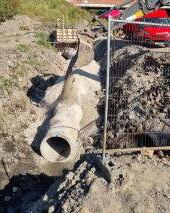
In June last year, we were on the Lichfield Canal on a joint weekend with London WRG, carrying out final towpath work at Darnford Moors prior to test watering. This section has been under restoration on and off for a very long time, with many of us having worked on the lift bridge, piling and initial profiling in the early 2000s and before, so it was great to be able to lend a hand in the final stages of returning this section to water, and exciting to follow progress online over the next couple of months as the watering was completed and this section of canal came back to life. [See also pages 31-33]
As well as running weekends, we also take charge of one of the WRG summer camps. Last year this was in early July, at John Robinson lock on the Cotswold Canals. This is a project we have visited multiple times over the last couple of years helping with the preparation works, site scrub clearance and initial chamber clearance, so it was great to be there as the middle week of five weeks of camps. We completed the chamber clearance and erected the last couple of bays of scaffolding, pointed-up brickwork and brought the chamber walls almost up to final height. A highlight of the week was a boat trip along the restored section of canal from Wallbridge lock in Stroud up to the new site of the Stroud Brewery just shy of Hope Mill Lock and Brimscombe. As a group we had worked on all three of Bowbridge, Griffin Mill and Ham Mill locks over the last decade, so it was a real treat to bore the new volunteers with stories and reminiscences of the various sites… “You see that little alcove in the wall up there? – Roy did that, you know….”, “Ooh, just here is where a volunteer lost their glasses to the depths in 2002…”
At the start of September we ran a long weekend on the Beggarlee project on the Cromford Canal, where a deadline was looming to complete drainage work before permissions expired. We were able to pull in a great team of volunteers and made really important progress converting an existing large culvert outfall to an enclosed chamber, and extending in large concrete pipe sections from there under what will eventually be the canal embankment to a new outfall. This weekend was a great example of how we can organise a dig and draw in volunteers outside our regular core group with the range of skills necessary to tackle what was a complex and technically challenging task.
The following very hot weekend a couple of us joined the Wey and Arun Canal Trust on their Drive a Digger stand at the Surrey Hills Wood Fair. This was a great opportunity to engage with the public and help raise funds for the Trust, and a complete and interesting contrast to our more typical dig weekends.
In October we were back to a more traditional weekend at John Robinson lock, finishing off work from the summer camps, including cutting out a ladder recess, completing the brickwork on the main chamber walls and continuing the patching under bridge.
Later in October Ed and I had the pleasure of joining the Wey and Arun Trust at the opening of Birtley lift bridge. This was a project we had worked on over a summer camp and a couple of weekends back in 2019, and it was fantastic to see both the bridges installed and operational, and walk the canal line from there to what will hopefully be a new project at Rooks Bridge in the near future.
Traditionally our December weekend is a joint Xmas party with London WRG and WRG Forestry. This year we were on the Wey and Arun clearing a long stretch of offside hedge to allow access for the felling

Progress at John Robinson: February 2023…
of a number of diseased ash trees below Brewhurst lock. This was a great social weekend with the accommodation at capacity - and despite a non-functional cooker dictating conversion from turkey roast to casserole, Eli came up trumps and we were not culinarily disappointed.
In February we returned to the Wey and Arun, this time clearing offside undergrowth below Devils Hole lock and around the winding hole to facilitate their trip boat excursions. One of the joys of visiting this stretch of the Wey and Arun is boating to site on the work flats through either Loxwood or Brewhurst locks, both of which we have worked on over the years.
In early March we were back to John Robinson lock, this time clearing all the scrub from the banks of the brook in preparation for the works to install the culvert under the head of the lock, hopefully by this year’s WRG Summer Camps. We awoke to snow on Sat morning with the brook in flood, but that didn’t dampen our spirits, and we were able to crack open a box of broken biscuits in memory of Mr Mac over tea break.
At the end of March we were on the Wey and Arun for a joint dig with London WRG, this time working on bank repair and protection above Devils Hole lock. This gave
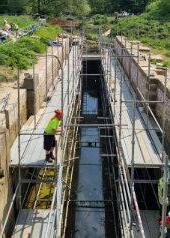
us an opportunity to walk up the canal with Bill from NWPG and Dave and Adam from the trust for a site visit to the newly acquired length of canal just north of the currently navigable section, where we will be holding our respective summer WRG Camps this July with the task of kicking off the relaying of around a kilometre of badly degraded towpath through Bonfire Hanger leading up to Sidney Wood.
In May we were back again at the Stroud end of the Cotswold Canals, carrying on the work to complete and tidy up the lower steps at Dock Lock, and install the lock ladder and continue the setting of coping stones on the neighbouring John Robinson lock. A highlight of this weekend was walking back from the pub to the accommodation in Saul on the Friday night by the light of the Aurora Borealis… which we did finally convince ourselves was not just the bright lights of Gloucester and Bristol.
By the time you read this we will have visited Weymoor bridge on the Cotswolds where we will be diverting a stream to enable the WRG Summer Camps to tackle the construction of a new culvert for the stream under the canal line. Our next weekend dig is Sept 7/8 at Weymoor, polishing off after the summer camps. These weekends where we or the other visiting groups can come in and carry out preparation works for summer camps, or the September/October weekends where we can finish off Summer Camp projects are really valuable contributions to the overall volunteer effort, ensuring that camps can hit the ground running, and a smooth transition handover of sites back to the local trusts after the summer.
If you are a canal trust with a project where you think we might be able to help you out with some focussed skills and labour, Ed Walker (our working party coordinator) would love to hear from you - similarly if you are a volunteer with some spare weekends itching to be filled with a variety of projects on a number of different canals then we’d both love to have you along. Our website (www.kescrg.org.uk) has more information on what to expect on a dig weekend, our current diary and a contact form. We also have a Facebook group which tends to have the most up-to-date information – search for Kescrg and ‘like and subscribe’! In the meantime, have a great summer of happy digging.
Stephen Davis (Kescrg Chair) …and the same view in May 2024
